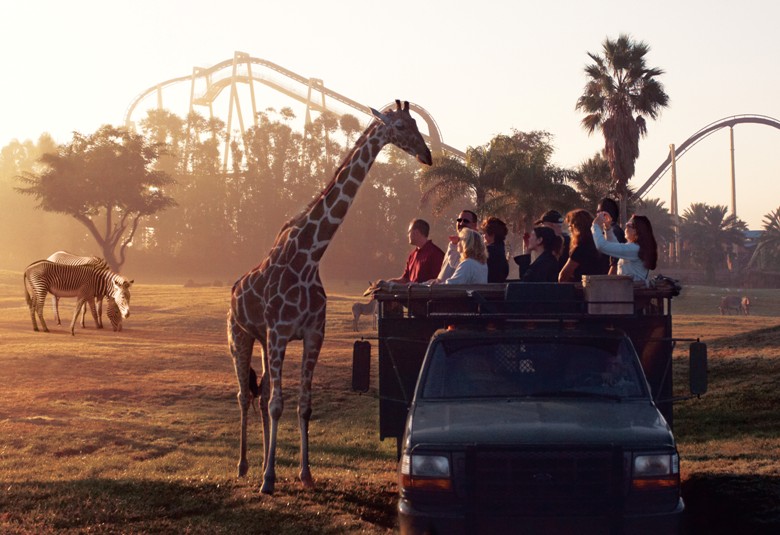Families get up close and with the animals at Busch Gardens in Tampa


By Eileen Ogintz
Tribune Content Agency
This is one birthday cake guaranteed to please.
It’s huge, shaped like a zebra, complete with the distinctive stripes. Only this cake was made to please a lion cub rather than a human child so it was fashioned from raw meat.
Welcome to the state-of-the-art Animal Care Center at Busch Gardens in Tampa, Florida — a unique 16,000-square-foot facility opened a little more than two years ago where visitors can watch how the park’s veterinarians take care of the animals that live here, from preparing special treats to X-rays and surgeries performed behind huge glass windows. A camera connected to the clinical laboratory’s microscope allows guests to see what the staff looking into the microscope sees.
You might see a surgery on a bald eagle’s broken wing or observe a gibbon’s wellness check-up. During the procedures, the zoo educators talk about what is taking place and afterward the vets will get on the microphone and explain what was done, what they found and what the next steps will be.
“Kids are fascinated. They come right up to the glass to watch,” said Dr. Dominique Keller, one of the park’s senior veterinarians. “Absolutely there are some future vets here. The kids ask more questions than the adults.”
I’d be remiss if I didn’t mention that SeaWorld Entertainment, Busch Gardens’ parent company, has been taking tremendous flack for SeaWorld’s killer whale program through a documentary and huge social media-driven campaign. But I think it is also important to recognize that this company is a global leader in animal care conservation. It donates more than $50 million to conservation, wildlife rescue and environmental initiatives and operates one of the most respected animal rescue and rehabilitation programs in the country. The Animal Care Center is part of those ongoing efforts.
When I visited one day recently, a group of summer campers — Busch Gardens runs many camps, including week-long overnight camps — were busy creating “enrichment” toys and boxes for some of the animals in the center’s big nutrition kitchen, using pine cones, scented strips of paper, honey, paper towel tubes and more. “It’s really fun,” said 9-year-old Haley. “I got to feed an armadillo!”
There’s no charge to watch the procedures here, though there are special 75-minute behind-the-scenes tours ($29) that give you the chance for a more hands-on experience. (A tip from Dr. Keller: More of the procedures are scheduled in the morning so stop by as soon as you come to the park.)
Certainly Busch Gardens has its share of shows (Iceploration is the popular ice show and everyone loves Critter Castaways with dogs, cats, even doves performing tricks), world-class coasters — the Cheetah Hunt, the about to open Falcon’s Fury (the tallest freestanding drop tower in North America at 335 feet) and the wooden coaster Gwazi among them — as well as a “Sesame Street” Safari of Fun area for the youngest park goers. But what sets this park apart, of course, is the chance to get up close to so many exotic animals — more than 12,000, representing 307 species.

(TIP: Be mindful of the heat and sun in summer. Come with reusable water bottles and hats. Look for the “Select Your Day, Select Your Savings” ticket that offers savings up to $30, if you purchase before you visit. Save more if you buy a combined ticket to Busch Gardens and SeaWorld Orlando. If you plan to visit other Tampa Bay attractions, consider the new Tampa Bay CityPASS, which gives you entrance to five area attractions for $119 ($99 for kids 3 to 9), not much more than the $95 admission ($90 for kids to Busch Gardens).
Check out the four-acre Jungala area, complete with a three-story maze of nets and rope bridges and Jambo Junction where kids can meet some animals and learn a lesson or two about conservation. Are you ready to join the flamingos on parade?
Did you know giraffes eat 60 pounds of leaves a day? We learned that when we fed Ruby the giraffe on the Serengeti Safari ($39 per person). We rode out to the “Serengeti Plain,” home to hundreds of African animals — zebras, rhinos, wildebeests, antelopes and ostriches — that mimics their natural habitat with African grasses, bluffs, creek beds and mud banks.
The highpoint, we all agreed, was feeding Ruby lettuce — and taking home the pictures to prove it. “That alone was worth the price,” said Kim Avant, here with her husband and three sons from South Carolina.
Later, we meet Gloria, a white skunk and Benny, a red-crested African bird. There’s Ollie, the three-banded Armadillo, who curls up into a ball, and rainbow macaws. “Spork,” the Spoonbill, is being trained to fly between guests. They’re all Busch Gardens “animal ambassadors,” who travel around the country (they get their own plane seats and stay in hotel rooms) and around the park.
Such interactions with the animals are a great way to show kids that what they do at home can have an impact on protecting animals in the wild, explained Jose Dominguez, an education supervisor.
To that end, SeaWorld has launched a new Generation Nature initiative offering interactive games, digital apps, video blogs and activities designed to get kids to be more environmentally aware. Bindi Irwin, 15, is their guide. (Kids are encouraged to share their conservation efforts — whether taking a shorter shower to save water, saving power by unplugging a charger, or carpooling. Kids can earn points for completing a conservation challenge, with SeaWorld directing funds for each point earned to the SeaWorld & Busch Gardens Conservation Fund. The kids can direct which program their points support — like saving penguins.
“We tell the kids they can act locally, and have an impact globally,” says Dominguez.
Good point! Now where’s that recycling bin?
© 2014 EILEEN OGINTZ, DISTRIBUTED BY TRIBUNE CONTENT AGENCY, LLC.
